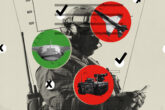March 05, 2024
Drones Are Transforming the Battlefield in Ukraine but in an Evolutionary Fashion
This article was originally published in War on the Rocks.
Headlines would lead one to conclude that the age of killer robots has arrived. In Ukraine, autonomous drone swarmssupposedly hunt for enemies and independently decide what to attack. Because Ukraine and Russia are employing many different types of drones, which are omnipresent over the frontlines, some observers have concluded that drones have fundamentally changed the character of war and are the key factor that will decide who prevails in the conflict. In my new Center for a New American Security Report, Evolution Not Revolution: Drone Warfare in Russia’s 2022 Invasion of Ukraine, I conclude the opposite. Drones have not fundamentally altered the character of war and will not determine who wins or loses this war. Nevertheless, drones are changing how Ukrainian and Russian troops fight at a tactical level and will impact all future battlefields.
Thus far in Ukraine, drone warfare has been an evolution, not a revolution.
Drones have indeed transformed the battlefield in Ukraine by providing accessible and affordable capabilities at a scale that did not previously exist. They are making it difficult to concentrate forces, achieve surprise, and conduct offensive operations. While drones are not more survivable than crewed aircraft, they enable greater risk acceptance. Moreover, drones do not have to be survivable if they are cheap and plentiful as they can achieve resiliency by reconstitution. Nevertheless, the overall impact of drones has been more evolutionary than revolutionary. Drones connected to ground-based fires units have made common artillery shells precision weapons. First-person-view kamikaze drones can accurately hit mobile targets, making the frontlines even more lethal. Nevertheless, even large numbers of small drones cannot match the potency or volume of artillery fire and thus cannot substitute for howitzers. Also, while drones provide affordable airpower, they have not replaced traditional air forces, nor have they been able to obtain air superiority. With this in mind, Washington should continue helping Ukraine improve its drone fleet, while being realistic about the impact this will have.
Read the full article from War on the Rocks.
More from CNAS
-
Safe and Effective
The promise of artificial intelligence (AI) and autonomy to change the character of war inches closer to reality...
By Josh Wallin
-
America’s Eroding Airpower
To have a chance at success, the United States would need more low-end drones and missiles that can provide it with mass....
By Stacie Pettyjohn
-
Build Allied AI or Risk Fighting Alone
Amid the hype about artificial intelligence (AI) and autonomous systems, militaries around the world are developing, experimenting with, and integrating these tools into every...
By Becca Wasser & Josh Wallin
-
The Evolution of Drones with Stacie Pettyjohn, Center for a New American Security
Stacie Pettyjohn, Senior Fellow and Director of the Defense Program at the Center for a New American Security, joins Squaring the Circle to discuss the evolution of drones. ...
By Stacie Pettyjohn




